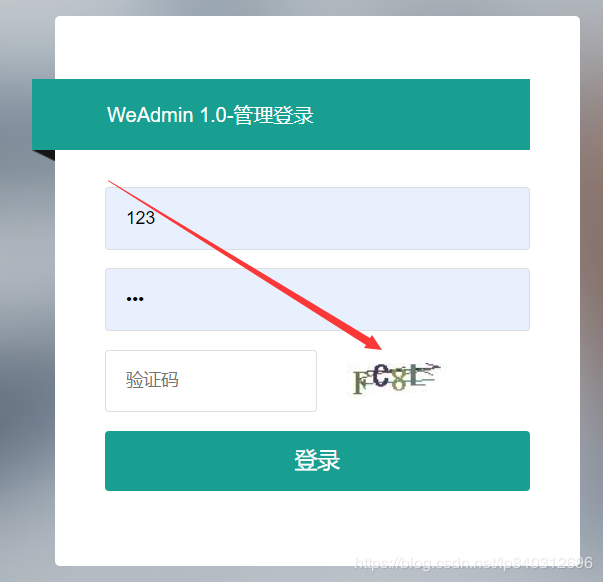SpringBoot——登录验证码实现
2020-04-09 16:08:45来源:博客园 阅读 ()

SpringBoot——登录验证码实现
今天记录一下验证码的实现,希望能够帮助到大家!
首先我们看一下实现的效果:

此验证码的实现没有用到太多的插件,话不多说直接上代码,大家拿过去就可以用。
中间用到了org.apache.commons.lang3.RandomUtils工具类,需要pom配置:
<!-- https://mvnrepository.com/artifact/org.apache.commons/commons-lang3 --> <dependency> <groupId>org.apache.commons</groupId> <artifactId>commons-lang3</artifactId> <version>3.10</version> </dependency>
1.验证码类
package com.youyou.login.util.validatecode; import lombok.Data; /** * 验证码类 */ public class VerifyCode { private String code; private byte[] imgBytes; private long expireTime; public String getCode() { return code; } public void setCode(String code) { this.code = code; } public byte[] getImgBytes() { return imgBytes; } public void setImgBytes(byte[] imgBytes) { this.imgBytes = imgBytes; } public long getExpireTime() { return expireTime; } public void setExpireTime(long expireTime) { this.expireTime = expireTime; } }
2.验证码生成接口
package com.youyou.login.util.validatecode; import java.io.IOException; import java.io.OutputStream; /** * 验证码生成接口 */ public interface IVerifyCodeGen { /** * 生成验证码并返回code,将图片写的os中 * * @param width * @param height * @param os * @return * @throws IOException */ String generate(int width, int height, OutputStream os) throws IOException; /** * 生成验证码对象 * * @param width * @param height * @return * @throws IOException */ VerifyCode generate(int width, int height) throws IOException; }
3.验证码生成实现类
package com.youyou.login.util.validatecode; import com.youyou.util.RandomUtils; import org.slf4j.Logger; import org.slf4j.LoggerFactory; import javax.imageio.ImageIO; import java.awt.*; import java.awt.image.BufferedImage; import java.io.ByteArrayOutputStream; import java.io.IOException; import java.io.OutputStream; import java.util.Random; /** * 验证码实现类 */ public class SimpleCharVerifyCodeGenImpl implements IVerifyCodeGen { private static final Logger logger = LoggerFactory.getLogger(SimpleCharVerifyCodeGenImpl.class); private static final String[] FONT_TYPES = { "\u5b8b\u4f53", "\u65b0\u5b8b\u4f53", "\u9ed1\u4f53", "\u6977\u4f53", "\u96b6\u4e66" }; private static final int VALICATE_CODE_LENGTH = 4; /** * 设置背景颜色及大小,干扰线 * * @param graphics * @param width * @param height */ private static void fillBackground(Graphics graphics, int width, int height) { // 填充背景 graphics.setColor(Color.WHITE); //设置矩形坐标x y 为0 graphics.fillRect(0, 0, width, height); // 加入干扰线条 for (int i = 0; i < 8; i++) { //设置随机颜色算法参数 graphics.setColor(RandomUtils.randomColor(40, 150)); Random random = new Random(); int x = random.nextInt(width); int y = random.nextInt(height); int x1 = random.nextInt(width); int y1 = random.nextInt(height); graphics.drawLine(x, y, x1, y1); } } /** * 生成随机字符 * * @param width * @param height * @param os * @return * @throws IOException */ @Override public String generate(int width, int height, OutputStream os) throws IOException { BufferedImage image = new BufferedImage(width, height, BufferedImage.TYPE_INT_RGB); Graphics graphics = image.getGraphics(); fillBackground(graphics, width, height); String randomStr = RandomUtils.randomString(VALICATE_CODE_LENGTH); createCharacter(graphics, randomStr); graphics.dispose(); //设置JPEG格式 ImageIO.write(image, "JPEG", os); return randomStr; } /** * 验证码生成 * * @param width * @param height * @return */ @Override public VerifyCode generate(int width, int height) { VerifyCode verifyCode = null; try ( //将流的初始化放到这里就不需要手动关闭流 ByteArrayOutputStream baos = new ByteArrayOutputStream(); ) { String code = generate(width, height, baos); verifyCode = new VerifyCode(); verifyCode.setCode(code); verifyCode.setImgBytes(baos.toByteArray()); } catch (IOException e) { logger.error(e.getMessage(), e); verifyCode = null; } return verifyCode; } /** * 设置字符颜色大小 * * @param g * @param randomStr */ private void createCharacter(Graphics g, String randomStr) { char[] charArray = randomStr.toCharArray(); for (int i = 0; i < charArray.length; i++) { //设置RGB颜色算法参数 g.setColor(new Color(50 + RandomUtils.nextInt(100), 50 + RandomUtils.nextInt(100), 50 + RandomUtils.nextInt(100))); //设置字体大小,类型 g.setFont(new Font(FONT_TYPES[RandomUtils.nextInt(FONT_TYPES.length)], Font.BOLD, 26)); //设置x y 坐标 g.drawString(String.valueOf(charArray[i]), 15 * i + 5, 19 + RandomUtils.nextInt(8)); } } }
4.工具类
package com.youyou.util; import java.awt.*; import java.util.Random; public class RandomUtils extends org.apache.commons.lang3.RandomUtils { private static final char[] CODE_SEQ = { 'A', 'B', 'C', 'D', 'E', 'F', 'G', 'H', 'J', 'K', 'L', 'M', 'N', 'P', 'Q', 'R', 'S', 'T', 'U', 'V', 'W', 'X', 'Y', 'Z', '2', '3', '4', '5', '6', '7', '8', '9' }; private static final char[] NUMBER_ARRAY = { '0', '1', '2', '3', '4', '5', '6', '7', '8', '9' }; private static Random random = new Random(); public static String randomString(int length) { StringBuilder sb = new StringBuilder(); for (int i = 0; i < length; i++) { sb.append(String.valueOf(CODE_SEQ[random.nextInt(CODE_SEQ.length)])); } return sb.toString(); } public static String randomNumberString(int length) { StringBuilder sb = new StringBuilder(); for (int i = 0; i < length; i++) { sb.append(String.valueOf(NUMBER_ARRAY[random.nextInt(NUMBER_ARRAY.length)])); } return sb.toString(); } public static Color randomColor(int fc, int bc) { int f = fc; int b = bc; Random random = new Random(); if (f > 255) { f = 255; } if (b > 255) { b = 255; } return new Color(f + random.nextInt(b - f), f + random.nextInt(b - f), f + random.nextInt(b - f)); } public static int nextInt(int bound) { return random.nextInt(bound); } }
经过以上代码,我们的验证码生成功能基本上已经实现了,现在还需要一个controller来调用它。
@ApiOperation(value = "验证码") @GetMapping("/verifyCode") public void verifyCode(HttpServletRequest request, HttpServletResponse response) { IVerifyCodeGen iVerifyCodeGen = new SimpleCharVerifyCodeGenImpl(); try { //设置长宽 VerifyCode verifyCode = iVerifyCodeGen.generate(80, 28); String code = verifyCode.getCode(); LOGGER.info(code); //将VerifyCode绑定session request.getSession().setAttribute("VerifyCode", code); //设置响应头 response.setHeader("Pragma", "no-cache"); //设置响应头 response.setHeader("Cache-Control", "no-cache"); //在代理服务器端防止缓冲 response.setDateHeader("Expires", 0); //设置响应内容类型 response.setContentType("image/jpeg"); response.getOutputStream().write(verifyCode.getImgBytes()); response.getOutputStream().flush(); } catch (IOException e) { LOGGER.info("", e); } }
搞定!后台编写到此结束了。那么又会有博友说了:“说好的实现效果呢?”
好吧,那么我们继续前端的代码编写。
前端代码:
<html> <body> <div> <input id="code" placeholder="验证码" type="text" class="" style="width:170px"> <!-- 验证码 显示 --> <img οnclick="javascript:getvCode()" id="verifyimg" style="margin-left: 20px;"/> </div> <script type="text/javascript"> getvCode(); /** * 获取验证码 * 将验证码写到login.html页面的id = verifyimg 的地方 */ function getvCode() { document.getElementById("verifyimg").src = timestamp("http://127.0.0.1:81/verifyCode"); } //为url添加时间戳 function timestamp(url) { var getTimestamp = new Date().getTime(); if (url.indexOf("?") > -1) { url = url + "×tamp=" + getTimestamp } else { url = url + "?timestamp=" + getTimestamp } return url; }; </script> </body> </html>
可以实现点击图片更换验证码。
实现效果:

当然文章开头的截图是我系统中的截图,需要大家自己去根据自己的情况去开发前端了。
原文链接:https://blog.csdn.net/qq_37651267/article/details/99305573
原文链接:https://www.cnblogs.com/qiantao/p/12670517.html
如有疑问请与原作者联系
标签:
版权申明:本站文章部分自网络,如有侵权,请联系:west999com@outlook.com
特别注意:本站所有转载文章言论不代表本站观点,本站所提供的摄影照片,插画,设计作品,如需使用,请与原作者联系,版权归原作者所有
- springboot2配置JavaMelody与springMVC配置JavaMelody 2020-06-11
- SpringBoot 2.3 整合最新版 ShardingJdbc + Druid + MyBatis 2020-06-11
- 掌握SpringBoot-2.3的容器探针:实战篇 2020-06-11
- nacos~配置中心功能~springboot的支持 2020-06-10
- SpringBoot + Vue + ElementUI 实现后台管理系统模板 -- 后 2020-06-10
IDC资讯: 主机资讯 注册资讯 托管资讯 vps资讯 网站建设
网站运营: 建站经验 策划盈利 搜索优化 网站推广 免费资源
网络编程: Asp.Net编程 Asp编程 Php编程 Xml编程 Access Mssql Mysql 其它
服务器技术: Web服务器 Ftp服务器 Mail服务器 Dns服务器 安全防护
软件技巧: 其它软件 Word Excel Powerpoint Ghost Vista QQ空间 QQ FlashGet 迅雷
网页制作: FrontPages Dreamweaver Javascript css photoshop fireworks Flash
